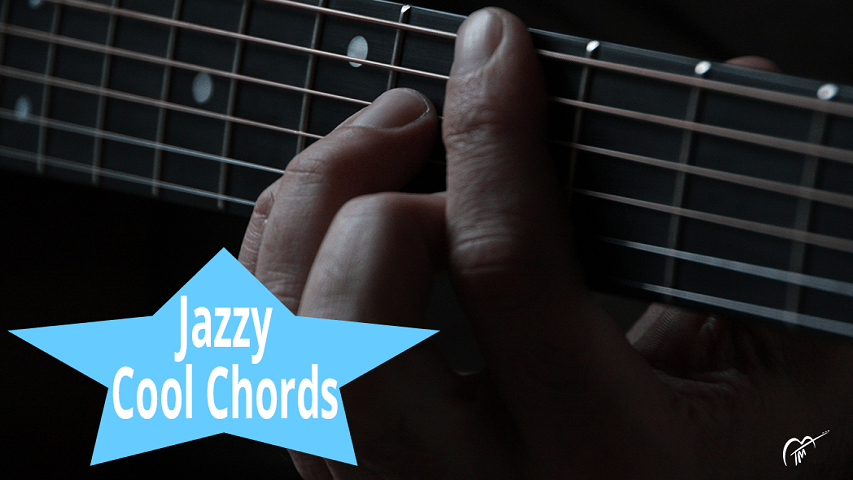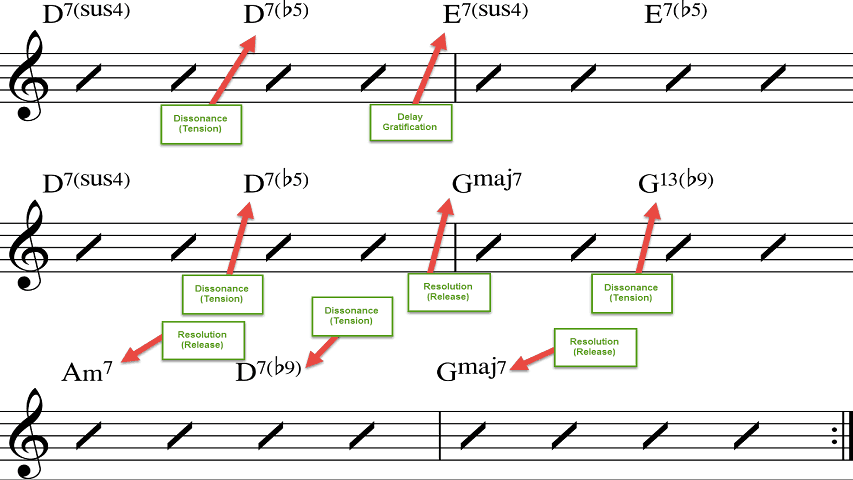
One of the most fun parts of learning guitar for me is when I learned some new chords that sound good. It wasn't always like that though.
In my early days I found learning new chords kind of annoying. Especially the more interesting and dissonant chords. I think that's because no matter what I did they just didn't sound good.
Fortunately I discovered over time that some of the chords I really like now just don't sound good by themselves. They sound good in the process of moving from one chord to another. And that's because of “dissonance”.
What Is Dissonance?
One of the elements that makes music interesting is what I'll call movement... The feeling of wanting to keep moving from one chord to another. The most common way to create that feeling of movement is by using chords that sound unstable.
It's usually caused by some of the intervals in the chord. The intervals that are most common are a minor 2nd (otherwise known as a half step) and the famous tritone, also known as an augmented 4th.
This feeling of on stability of wanting to move is what we call dissonance. When you go to a more stable chord from a dissonant chord is called "resolution". The dissonant chord creates a feeling of tension, and then the more stable chord gives you the feeling of relieving the tension… Tension and Release. It's an amazing mechanism and used constantly in music.
Example Of Dissonance And Resolution
There are some great examples of dissonance and resolution in the chord progression in this lesson.
In the beginning there is what I call a soft version of dissonance. That 2nd chord... the D7(b5)... feels like it wants to go somewhere. But instead of resolving it we want to keep the motion going (delay gratification). This is done by moving it up and doing the same thing with the E7sus4… going to the E7(b5).

Finally you do feel a sense of resolution when it finally goes to that GMaj7 which is a very stable chord. In fact this chord is the most stable chord because it’s the home chord of this progression… Meaning it's the 1 chord of the key… key of G).
Two More Dissonant Examples
Another chord that is very dissonant is the G13(b9). This resolves by going to the Am7 which is a more stable chord.
Finally, what many would consider the most distant chord, is the final D7(b9). Because of both the progression and the dissonance in this chord there’s a strong feeling of wanting to go back home… And it does. Can you guess how?
Hint: it goes to the most stable chord in this progression.
If you guessed it wants to go back to the beginning of the progression to the GMaj7 (home chord) you'd be absolutely 100% unequivocally correct.
Jazz Guitar Chord Progression Practice Tips
Now let's put all this theoretical pondering stuff into practice.
1. Start by learning the fingering for one chord at a time. Put your fingers in the proper positions, play the chord, and then release your fingers and start over. Now let's put all this theoretical pondering stuff into practice.
2. If you find the fingering difficult try working on just one chord a day… Or even for two days before moving on to the next chord.
3. Work on it a little bit each day. You'll be surprised how even a little bit over time can produce incredible results.
4. Once you feel reasonably comfortable with the first two chords start practicing moving from one to the other. The movement from one chord to another is the most important part. Sometimes it's even easier to go from one chord to another than to finger it by itself.
5. Continue adding chords to your "practice progression" and continue practicing moving through all the chords that you know.
6. Once you learn the final chords you can practice the entire progression slowly. Don’t worry about rhythm yet.
7. The next step is to try to do it in time (i.e. with rhythm). Start by keeping your own rhythm… You can just count inside your head or tap your foot (I like to tap my foot).
8. Now try practicing it with a metronome. Remember to go very slow at first… Probably slower than you think you need to go. Force yourself to change on time. Little by little you can speed up the metronome to make it more challenging.
If you’ve enjoyed this lesson and would like a more complete step-by-step approach (as well as the bossa nova rhythm I play at the end of the video) head on over to the Real Guitar School home dashboard and open the song lesson titled Jazzy Cool Chords.
If you're not a member of Real Guitar Success yet you can find out more about how to get this and many other great song lessons and learning modules here.
Why Learn This Chord Progression?
Tell Us What You Think - Please Comment Below!
We would love to hear your comments and questions. What specific things are you struggling with while learning guitar?

This subject is exactly what I need in my quest to play Gypsy Jazz, I need a chordal background to learn rhythm arrangements.
Also would love to play simple standards.